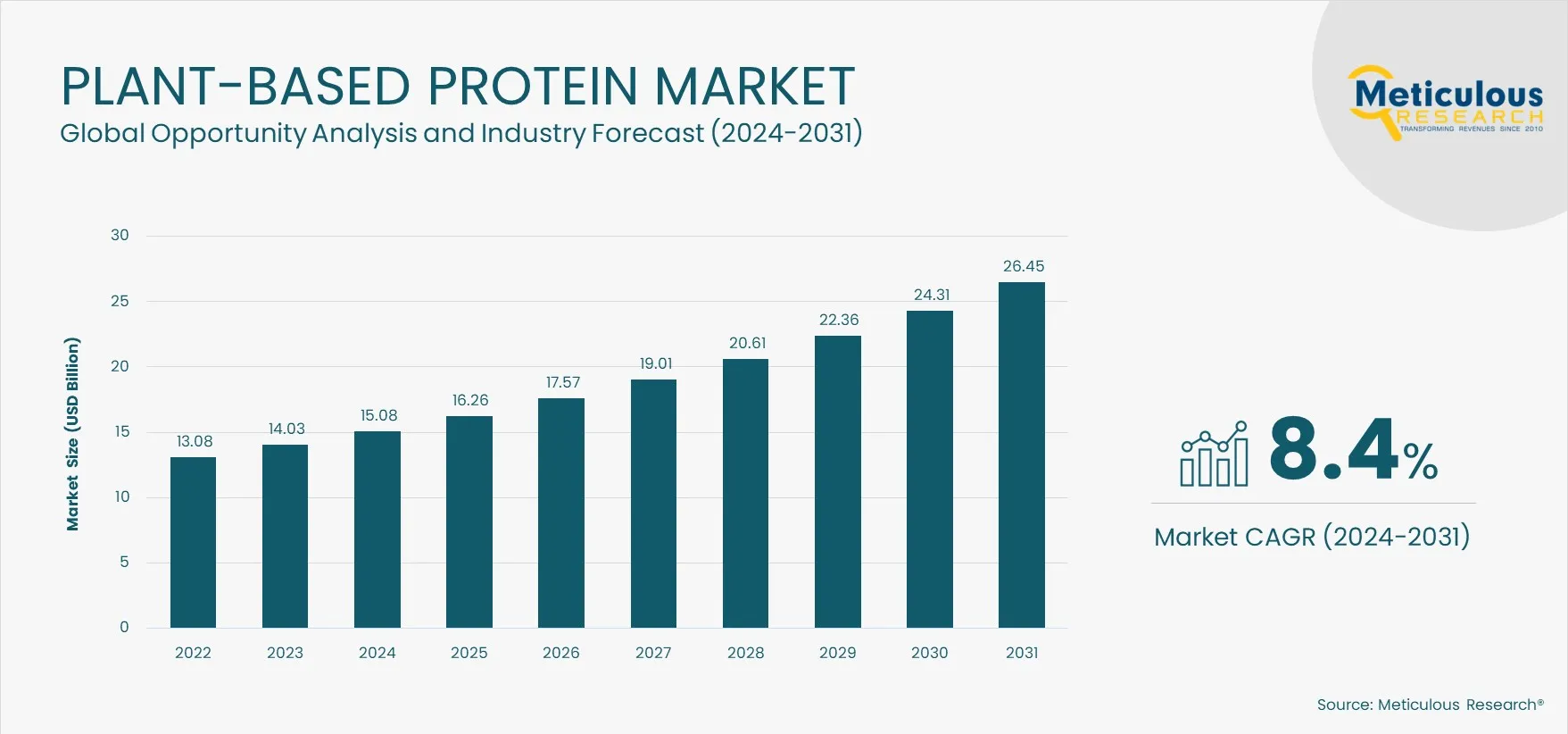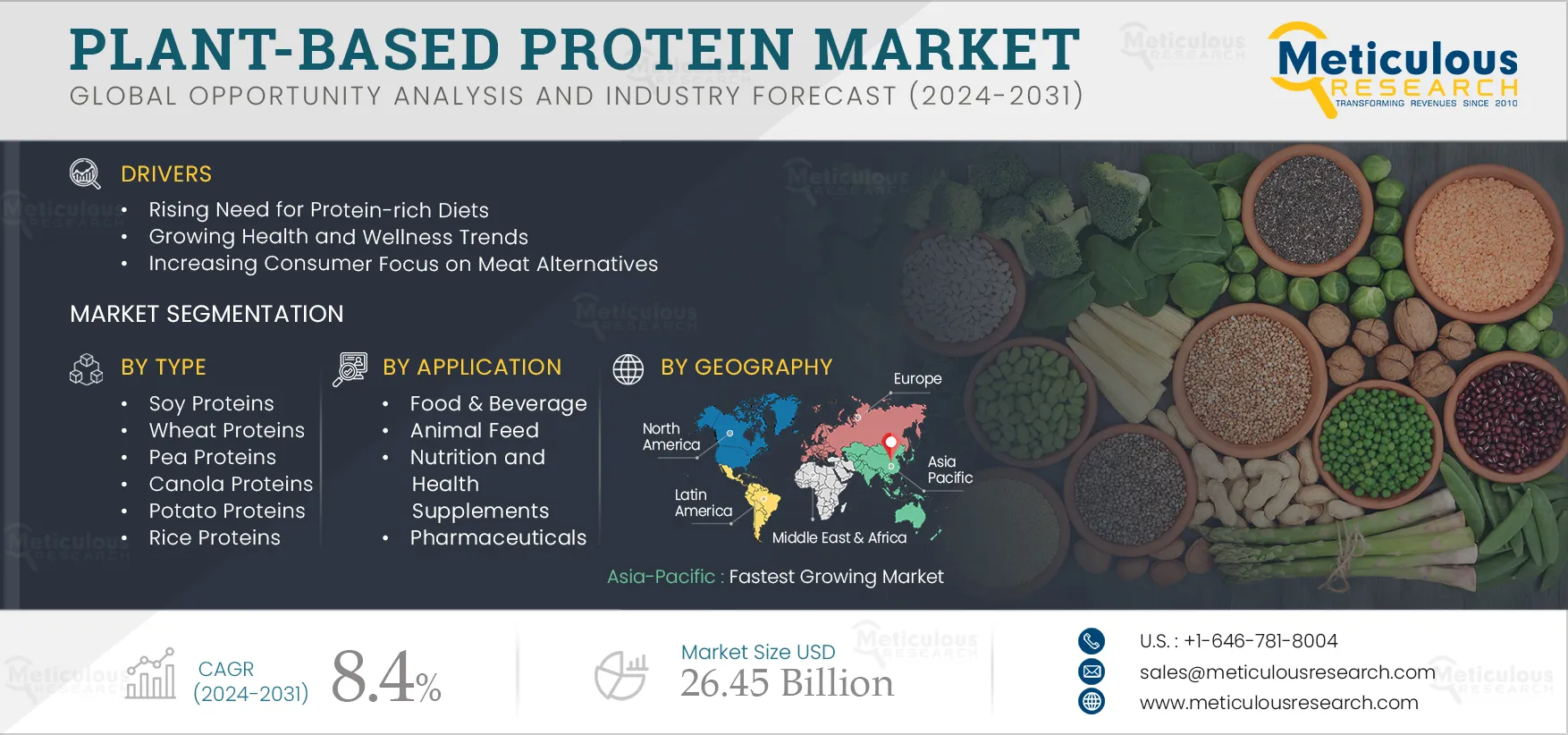The Plant-based Protein Market is projected to reach $26.45 billion by 2031, at a CAGR of 8.4% during the forecast period (2024–2031). The growth of the plant-based proteins market is mainly driven by the rising need for protein-rich diets, growing health and wellness trends, increasing consumer focus on meat alternatives, rising demand from the food & beverage industry, and advancements in ingredient technologies, such as microencapsulation. However, the consumer preference for animal-based products and fluctuating raw material prices are expected to hinder the growth of this market.
Furthermore, consumers’ increasing inclination toward plant-based diets, emerging economies, and rising prevalence of intolerance to animal proteins are expected to generate growth opportunities for the players operating in the plant-based proteins market.
Here are the top 10 companies operating in the Plant-based Protein Market
Archer Daniels Midland (ADM) Company
Founded in 1902 and headquartered in Illinois, U.S., Archer-Daniels-Midland Company (ADM) is involved in manufacturing, selling, and distributing food ingredients and flavors for foods and beverages, supplements, nutrition for pets and livestock, and more. The company operates through four business segments: Agricultural Services & Oilseeds, Carbohydrate Solutions, Nutrition, and Other Businesses.
The Nutrition segment manufactures, sells, and distributes natural flavor ingredients, flavor systems, natural colors, proteins, emulsifiers, soluble fiber, polyols, hydrocolloids, and natural health and nutrition products, including probiotics, prebiotics, enzymes, and botanical extracts; other specialty food and feed ingredients; edible beans; formula feeds, animal health, and nutrition products; and contract and private-label pet treats and foods. The company offers alternative proteins sourced from soy, wheat, pea, and yeast.
With around 480 crop procurement locations, more than 345 food & feed processing locations, and more than 50 innovation centers, the company has its geographic presence across North America, Europe, Asia-Pacific, Latin America, and the Middle East & Africa.
Founded in 1865 and headquartered in Minneapolis, U.S., Cargill, Incorporated is engaged in the manufacturing and marketing of food, agriculture, financial, and industrial products and services. The company operates through five business segments: Food Ingredients & Bio-industrial, Animal Nutrition, Protein & Salt, Agriculture Supply Chain & Energy, and Transportation & Metals. The company offers alternative proteins derived from soy, pea, wheat, and corn.
With manufacturing facilities in 70 countries, the company sells its products in more than 125 countries worldwide. The company conducts operations for alternative protein ingredients in the U.S., Canada, Central America, China & Southeast Asia, and the U.K.
Roquette Frères Le Romain
Founded in 1933 and headquartered in Lestrem, France, Roquette Frères is involved in producing specialty food ingredients and pharmaceutical excipients. The company operates through seven business segments: BioPharma, Pharma & Nutraceuticals, Cosmetics, Food & Nutrition, Animal Nutrition, Nutralys Plant Protein, and other Industrial Markets. The company offers alternative proteins, such as pea protein, wheat protein, potato protein, corn protein, and Chlorella through its Food & Nutrition segment.
With 25 operating plants and several sales subsidiaries, the company has a geographic presence in France, the U.S., China, Korea, Japan, Singapore, India, Mexico, France, Italy, Spain, Romania, the U.K., Germany, Finland, and the Russian Federation.
Ingredion Incorporated
Founded in 1906 and headquartered in Illinois, U.S., Ingredion Incorporated produces and sells ingredient solutions for various industries. Ingredion Incorporated was formerly known as Corn Products International, Inc. and changed its name to Ingredion Incorporated in June 2012.
The company offers its products through five business segments: Food, Animal Nutrition, Beverage, Brewing, and Other. The company offers plant-based proteins used in processed foods, such as bakery products, snacks & cereals, and meat substitutes through its Food segment.
The company has 47 manufacturing facilities and a geographic presence across North America, Europe, Asia-Pacific, Latin America, and the Middle East & Africa.
Kerry Group
Founded in 1972 and headquartered in Tralee, Ireland, Kerry Group is engaged in the research & development, and manufacture of functional ingredients and actives for the food, beverage, and pharmaceutical industries. The company operates via two business segments: Taste & Nutrition and Consumer Foods. Kerry Group offers alternative proteins through its Taste & Nutrition segment. The company’s alternative proteins are used in the pet food, meat & poultry, seafood, beverages, and bakery industries.
The company has a geographic presence across North America, Europe, Asia-Pacific, Latin America, and the Middle East & Africa.
International Flavors & Fragrances, Inc. (IFF) (U.S.)
Founded in 1958 and headquartered in New York, U.S., IFF is engaged in creating, manufacturing, and supplying flavors, fragrances, and cosmetic actives to the food & beverage, personal care, and household products industries. The company operates through four business segments: Nourish, Scent, Health & Biosciences, and Pharma Solutions. It provides alternative proteins through its Health & Biosciences segment. The company’s alternative proteins are used in the pet food, meat products, baby food, beverages, bakery, and dairy industries.
With more than 110 manufacturing facilities, 100 R&D centers, and 33,000 customers worldwide, the company has a geographic presence across North America, Europe, Asia-Pacific, Latin America, and the Middle East & Africa.
Tate & Lyle PLC
Founded in 1921 and headquartered in London, U.K., Tate & Lyle is engaged in providing ingredients and solutions to food & beverage and other industries. The company operates through three segments: Food & Beverage Solutions, Sucralose, and Primary Products. The company offers proteins derived from oats, wheat, and corn. The company’s offerings cater to beverages, dairy, bakery & snacks, soups, sauces & dressings, confectionery, personal care, and animal feed industries.
The company has a geographic presence across North America, Europe, Asia-Pacific, Latin America, and Middle East & Africa.
Axiom Foods Inc.
Founded in 2005 and headquartered in California, U.S., Axiom Foods is involved in manufacturing and distributing protein solutions, dairy alternatives, and sugars & syrups. The company provides organic, chemical-free, hexane-free, and allergen-free whole-grain brown rice protein and raw pea protein in the protein space. Axiom Foods offers these proteins to the food & beverage and sports nutrition industries. The company also offers alternative protein ingredients through its sister company, Growing Naturals LLC (California), founded in 2009. The company has a geographic presence throughout North America, Europe, and Asia-Pacific.
Burcon NutraScience Corporation (Canada)
Founded in 1998 and headquartered in Vancouver, British Columbia, Canada, Burcon Nutrascience is engaged in developing and manufacturing functional and renewable plant-based products. The company offers plant-based protein derived from peas and canola for the food & beverage industry.
The company has a geographic presence in North America, Europe, and Asia-Pacific.
BENEO GmbH (A Part of Südzucker AG) (Germany)
Founded in 2007 and headquartered in Mannheim, Germany, BENEO develops and produces ingredients for human and animal health. The company also provides high-quality bio-based chemicals. The company’s products are used for various applications, including baby food, bakery, cereals, beverages, confectionery, dairy, meat & vegetables, and soups & sauces. The company offers plant-based protein derived from rice, wheat, and faba beans.
With five production sites located in Belgium, Germany, Italy, and Chile, the company sells its products across North America, Europe, Asia-Pacific, and the Middle East & Africa.
Popular Mention: Cosucra Groupe Warcoing SA (Belgium), Now Health Group, Inc. (U.S.), AMCO Protein (U.S.), Glico Nutrition Co., Ltd (Japan), Glanbia Plc (Ireland), Sotexpro (France), Farbest-Tallman Foods Corporation (U.S.), Crespel & Deiters GmbH & Co. KG (Germany), Wilmar International (Singapore), and CHS Inc. (U.S.)

























